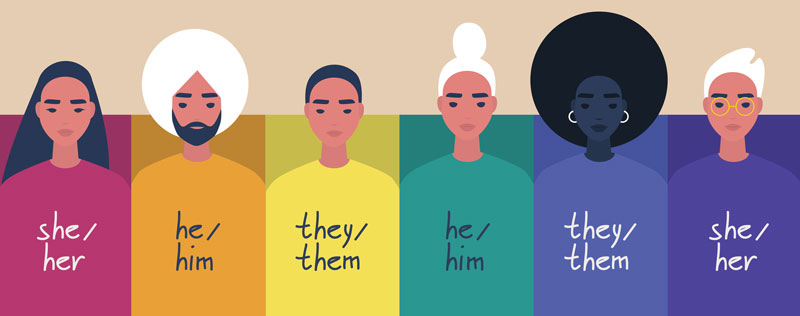Adding pronouns to conference badges, email signatures, and social media and videoconferencing profiles is more than just the new, cool thing in diversity and inclusion.
By Marcie Mathis, SWE Editorial Board
When those of us privileged to have our appearances match our gender identities and pronouns, the use of our own pronouns sets a stage for other folks to feel safe sharing their pronouns. In a 2018 All Together post, “Power of the Pronoun,” then-SWE director of diversity and inclusion Natalie Vanderspiegel (she/her) expressed it well.
In her blog post, Vanderspiegel wrote: “…being inclusive means appreciating that the experience of apparent gender and gender identity matching is not the same for everyone, and that we need to take steps to help others feel welcome and validated.”

Steps one can take
It is important to understand and live up to the responsibility that comes with displaying your pronouns or including them in an introduction. When you do this, you are letting folks know you understand the importance of respecting someone else’s gender identity and personal pronouns. Even though my appearance matches my gender identity and pronouns, as a member of the LGBTQ+ community, seeing someone using their pronouns also shows me they are an ally.
Making assumptions about someone’s personal pronouns based on their appearance can cause confusion and is experienced by that person as disrespectful. Continually or purposefully misgendering someone by using the wrong pronouns is not only disrespectful, however; it is a form of harassment, even if you do not intend harm.
“It is just as important to use the correct pronouns for someone as it is to get their name right.”
If you are having trouble using the correct pronouns for someone or applying some of the new-to-you pronouns, practice aloud on your own. Consider learning new pronouns to be similar to learning how to pronounce names that are unfamiliar. Also, rather than describing your pronouns as “preferred pronouns,” it is better to use the terms “personal pronouns” or simply “pronouns.”
I am always happy when I see someone who works in diversity and inclusion adding their pronouns to their email signature and other places, but it is even more gratifying when I see someone not in the diversity, equity, and inclusion field doing this. For example, I received an email from the property management company of my condominium complex where the sender included their pronouns, and it felt good to see that. I will often thank those folks. Also, the current lists of the SWE board of directors and board of trustees includes each member’s pronouns with their name.
If you are interested in more information, I found many good resources online through an internet search on “pronouns.” A June 2021 SWE All Together blog post, “The Evolution of Gender Pronouns – How, Why to Use Them in Email,” included information about the history of gender-expansive pronouns and about some of the pronouns in use today.
None of us will be perfect, even when we understand the importance of getting it right, but we can acknowledge and apologize in an appropriate, respectful way for the situation and then get it right the next time. Keep checking your assumptions, listening to others, and sharing your pronouns — doing so helps build community and enhance communication.
Marcie Mathis graduated from the University of Washington with a bachelor’s degree in electrical engineering. She has spent most of her engineering career as a civilian U.S. Navy employee and works at the Puget Sound Naval Shipyard and Intermediate Maintenance Facility in Bremerton, Washington. She joined SWE in 1988 as a student and serves on the multicultural committee and as a member of the editorial board.
Editor’s Note: Please see this issue’s media column for a related discussion.

